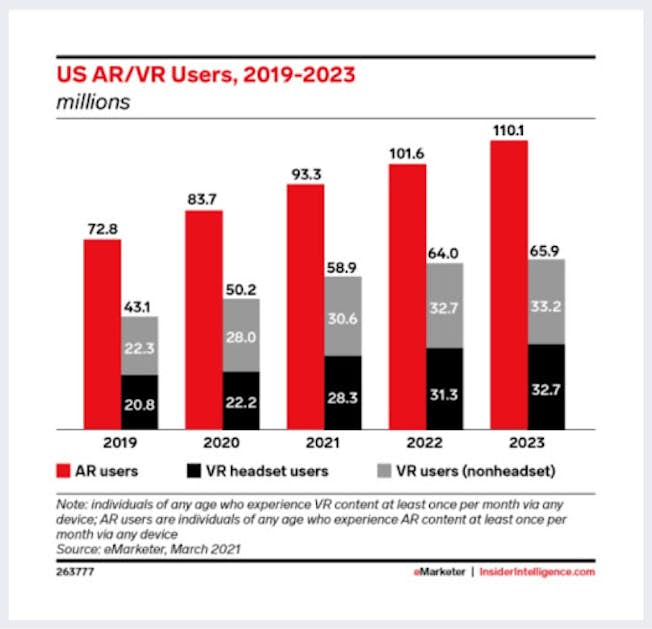It can be increasingly challenging to keep up with digital marketing trends as they change so quickly.
To help marketers and digital leaders navigate this new landscape, we’ve identified the key trends to help you improve engagement and drive conversions this year.
1. SOCIAL MEDIA TRENDS
TikTok Will Continue to Grow & Brands Need to Take it Seriously
The rapid rise of TikTok has seen the app reach 1 billion users and counting. The platform has enormous engagement (U.S. users spend up to 850 hours a month on the platform) and enables brands to create hyper-personalized content that truly connects with customers.
In terms of the platform’s revenue, TikTok was the top-earning non-game app in 2021 with more than $110 million spent by users. This just shows the earning potential of the app for marketers looking to drive sales amongst young consumers.

Influencers have also played a role in TikTok’s rise with many earning huge amounts through sponsorship deals. Battisby believes that brands are now taking notice of influencer marketing on the platform.
In the platform’s early days, it seemed to be a place for kids and teens and the influencer who want to reach them. But, today, we are seeing influencers like Gordon Ramsey and financial influencers like @johnefinance and @breakyourbudget who help GenZers learn about planning for their financial futures.
Social Commerce Will Become Seamless
During the pandemic, social commerce took off and is expected to reach $1.2 trillion globally by 2025 according to an Accenture study – a growth that’s three times faster than traditional ecommerce, aided by hashtags like #TikTokMadeMeBuyIt.
2022 is set to see the experience of social shopping evolve as platforms work behind the scenes to enable customer payments without leaving social media apps, creating a seamless customer experience. Gen Z and Millennials are predicted to be the biggest spenders as they will account for 62 percent of global social ecommerce revenue by 2025.

The key to driving engagement is for brands to create compelling shop windows on Instagram. It’s no longer enough to rely on one great image, companies need to have multiple images per product and add keyword-rich descriptions. Video is also crucial as the popularity of the format – as witnessed by TikTok’s growth and Instagram’s recent transition – is exploding across all audiences.
YouTube Advertising Will Explode
YouTube is going to explode in terms of investment from advertising in 2022. As more people move away from linear TV, fragmentation with subscriptions, and streaming services all means that more advertising spend is going to move to YouTube.
Last year YouTube’s global revenue (through its parent company Alphabet) grew to nearly $29 billion, up almost 46 percent from 2020. This level of revenue puts the social media platform on par with Netflix and is a result of the rise in more traditional TV advertisers on the channel, direct response ads, and brand advertising.

2. DIGITAL MARKETING JOB TRENDS IN 2022
Marketers Need to Upskill in Digital
As brands clamor to engage, promote, and convert successfully online, the need for digital talent across industries is intense.
A recent whitepaper, ‘Perpetual Evolution’, from The Economist Group, revealed that securing talent with the right skill set is the number one challenge that the digital marketing industry faces, while the lack of training to upskill marketers ranks seventh.

This demand is great news for marketers but poses a challenge for many in the industry who lack digital know-how or experience in digital marketing. So what digital marketing skills will be in demand in 2022? Social media skills remain in high demand, along with SEO and SEM.

The Digital Gig Economy is on the Rise
Over the past decade, many workers are pursuing a more flexible ‘gig’ lifestyle for their professional lives. The emergence and rise of online services and apps such as Airbnb and Deliveroo have offered new ways of working for people rather than a 9 to 5 traditional job.
In fact, according to a recent Mastercard study, half of the U.S. population will do gig work by 2028.
This gig economy opens up the door for marketers with in-demand skills. We are seeing more creative or digital marketing professionals choosing the digital nomad route as this enables them to dictate their own working hours and have flexibility.
3. DIGITAL TECHNOLOGY TRENDS IN 2022
The Metaverse Will Become a Marketer’s Playground
While it has existed and evolved for years, the metaverse saw a boost in interest after Facebook changed its parent company’s name to Meta in October 2021.
This move, according to Facebook’s CEO, Mark Zuckerberg is because “the metaverse is the next frontier in connecting people, just like social networking was when we got started. Over time, I hope we are seen as a metaverse company, and I want to anchor our work and our identity on what we’re building towards.”
So what is the metaverse? Basically, it’s virtual worlds in 3D that people can connect through Augmented Reality (AR) and Virtual Reality (VR). Imagine having an avatar that looks exactly like yourself with you exact measurements shopping in a virtual store. You would be able to try on clothes and see what they look like on your body from the comfort of your own sofa.
While we are still a few years away from reaching critical mass with the metaverse, brands are beginning to embrace it now to build on their customer experiences.
According to eMarketer research, there will be 65 million people that use VR and 110 million using AR every month in 2023. That’s a lot of potential young customers to have in one space.

Artificial Intelligence Will Hinder & Help Data Privacy
Privacy issues continue to plague brands as more customers demand transparency and control over their own data and we are seeing increasing concerns as AI continues to evolve the customer experience.
According to a Gartner study, 40% of privacy compliance technology will use AI by 2023 while global spending on privacy is expected to reach $8 billion by 2022.
However, companies can use AI in their data privacy initiatives to classify sensitive data and use it to search data to identify individuals that have asked to be forgotten (a specification covered under privacy regulations like GDPR).
The bottom line is the digital marketing space is changing rapidly and brands need to ensure they are testing new tactics and technologies while building the right presence across these new channels. If you need assistance taking a future-forward look at your brand’s digital presence and engagement, contact us today. Our experts are here to help.







